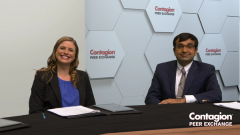
Antibiotics for CDI: Administration Strategies and Treatment Guidelines
Experts consider optimal approaches to administering therapy for CDI and share insight on available treatment guidelines.
Episodes in this series

Transcript:
James A. McKinnell, MD: At certain times, infectious disease doctors get, I’ll say, creative with how we approach some problems. There are a lot of treatments that we try: extended-use vancomycin, these 6- to 8-week tapers, rifaximin chasers. There’s a lot in that space. How do you guys, as microbiome experts, react to that? What does that mean from a strategic approach toward C diff [Clostridioides difficile]?
Carl V. Crawford, MD: The antibiotic we’re using that’s the narrowest in spectrum is the preferred agent because of the pathophysiology of this particular infection. I tend to use longer courses of antibiotics in individuals who don’t have access to another treatment that we can use as a cure later. We can talk about that in a little bit. I use extended courses probably as a second-line after failure of an initial fidaxomicin course or an initial vancomycin course. But the more antibiotics we use in individuals, the greater the collateral damage that we do to the system. I try to limit the amount of antibiotics I use unless it’s fidaxomicin, because it’s so narrow in its spectrum that you can continually suppress the C diff and hope that your tropical rainforest starts growing up around it.
James A. McKinnell, MD: The consensus is the idea that we want to use fidaxomicin maybe with this extended course, jumping from 5 days of full-dose therapy twice a day to twice a day, every other day.
Kelly R. Reveles, PharmD, PhD, BCPS: Potentially. That’s where we have some good data. Just to bring it back to why we even do this, when we taper these antibiotic therapies, it has a 2-pronged approach. Those antibiotic off days start to allow the normal gut microbiome to restore. At the same time, you may have remaining seed of spores in the gut that will germinate. The antibiotics don’t kill the spore phase, so you want it to germinate so you can knock it out once you redose those antibiotics.
James A. McKinnell, MD: We’ve described fidaxomicin as our selective weed polar. I want to tackle a topic that’s interesting because I have a hard time with guidelines. When I look at antibiotic guidelines, they’re somewhere out of date, they change; there are multiple versions. Kelly, you’re our guideline expert. What do you think about IDSA [Infectious Diseases Society of America] guidelines and recent changes?
Kelly R. Reveles, PharmD, PhD, BCPS: I really appreciated what ideas they did. We had a very full, complete, beautiful guideline published in 2018, but since that time we’ve had additional studies that favor, for example, fidaxomicin over oral vancomycin. What they did is more a targeted update with this new guideline where they just addressed these initial antibiotic therapies based on the new data. That’s something that the IDSA is pushing more for nowadays: to increase the speed at which new guidelines are published so that we have more up-to-date guidance on how to treat these patients.
Sahil Khanna, MBBS, MS: Kelly, just before I came to Vegas [Las Vegas, Nevada] for our meeting [American College of Gastroenterology Annual Scientific Meeting], the European guidelines came out. This is a remarkable year for C diff. We got the GI American College of Gastroenterology Guidelines, an update on the IDSA guidelines, and the European guidelines came out. With the guidelines in 2010 and 2013, we used something for the first time, it didn’t work, we used the same thing for the second time. We’ve gone away from that. We’ve become much smarter. I use something for the first time, it doesn’t work, I use something different. It’s like basic physiology how I think about it.
The thing that the European guidelines have done that’s different, is that they have tried to figure out who should get fidaxomicin or vancomycin just because of availability and cost issues, and they talk about people at higher risk of recurrence, increasing age, severe disease, and hospitalization history of C diff. The other thing the guidelines have done very well is to try to implement reoccurrence prevention strategies up front. C diff is not a treatment of this bug [with which you] go home and you’ll be fine. It’s treat this bug, and think about reoccurrence prevention strategies. The guidelines are incorporating immune-enhancing strategies like intravenous bezlotoxumab up front if you’re at a higher risk of recurrence and down the line too in a select patient population. All the guidelines are incorporating, which is good for us so we can then use them to get these medications approved.
James A. McKinnell, MD: Thank you for watching this HCP Live® Contagion® Peer Exchange. If you enjoyed the content, please subscribe to our e-newsletters to receive upcoming Peer Exchanges and other great content right in your in-box.
Transcript edited for clarity.
Newsletter
Stay ahead of emerging infectious disease threats with expert insights and breaking research. Subscribe now to get updates delivered straight to your inbox.
























































































































































































































































































